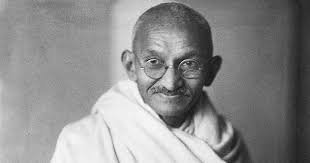Mahatma Gandhi Early Life and Formative Years in India and England
Mahatma Gandhi was born on October 2, 1869, in Porbandar, a coastal town in present-day Gujarat, India. Born into a devout Hindu family, his mother, Putlibai, instilled in him deep religious values, while his father, Karamchand Gandhi, served as the diwan (chief minister) of Porbandar. Few know that as a child, Gandhi was deeply afraid of the dark and ghosts—a fear he overcame through sheer willpower, foreshadowing his later resilience.
At 19, he traveled to London to study law, a decision that shocked his conservative caste community, who considered overseas travel forbidden. In England, he faced cultural challenges but also discovered vegetarianism and the works of Henry David Thoreau and Leo Tolstoy, which later influenced his philosophy of civil disobedience. A little-known fact is that Gandhi once took dancing and violin lessons in an attempt to become an English gentleman before embracing simplicity as his lifelong creed.
South Africa: The Birth of a Revolutionary
Gandhi’s transformation into a global symbol of resistance began not in India, but in South Africa. In 1893, while working as a lawyer, he was thrown off a train in Pietermaritzburg for refusing to leave a first-class compartment reserved for whites. This humiliating incident ignited his fight against racial injustice.
Over the next two decades, he developed Satyagraha (truth-force), a nonviolent resistance strategy. He led campaigns against discriminatory laws, including the infamous Black Act, which required Indians to carry fingerprint IDs. Few know that during this time, Gandhi established the Phoenix Settlement and Tolstoy Farm, experimental communities based on self-reliance and equality—early blueprints for his later ashrams in India.
Return to India and the Rise of a Mass Movement of Mahatma Gandhi
Gandhi returned to India in 1915, already a respected leader. Under the mentorship of Gopal Krishna Gokhale, he traveled across the country, witnessing the poverty and oppression under British rule. His first major campaign was in Champaran (1917), where he defended indigo farmers forced into exploitative labor. The success of this movement marked the beginning of his role as Mahatma (Great Soul), a title he reluctantly accepted.
A lesser-known story involves Gandhi’s fast unto death in 1918 during a mill workers’ strike in Ahmedabad. His fast pressured mill owners to raise wages, proving the power of moral authority over brute force.
Non-Cooperation and the Salt March: Defying an Empire
In 1920, Gandhi launched the Non-Cooperation Movement, urging Indians to boycott British goods, schools, and courts. The movement saw unprecedented mass participation but was suspended after the Chauri Chaura violence in 1922, revealing Gandhi’s unwavering commitment to nonviolence—even at the cost of political momentum.
His most iconic protest, the Salt March (1930), was a 240-mile trek to Dandi to produce salt, defying British monopoly. Few know that before the march, Gandhi sent a letter to Viceroy Lord Irwin, humorously addressed “Dear Friend,” stating his intentions—a blend of courtesy and defiance. The march sparked nationwide civil disobedience, with thousands arrested, including Gandhi himself.

Quit India and the Struggle for Independence
By World War II, Gandhi’s demand for British withdrawal crystallized into the Quit India Movement (1942). His call to “Do or Die” led to mass protests and brutal crackdowns. During this time, he was imprisoned in the Aga Khan Palace, where his wife, Kasturba, died. Gandhi’s grief was profound, yet he continued writing letters to the British, advocating peace even in captivity.
A little-known fact is that Winston Churchill despised Gandhi, calling him a “half-naked fakir,” and even proposed letting him die during a 1943 hunger strike. Yet, global pressure forced Britain to negotiate, culminating in India’s independence in 1947.
Mahatma Gandhi is Partition and the Tragedy of Division
Independence came at a horrific cost—the partition of India and Pakistan, sparking sectarian violence that killed over a million. Gandhi, who had opposed partition, toured riot-torn areas, fasting to stop the bloodshed. In Calcutta, his presence alone calmed mobs, earning him the moniker “One-Man Boundary Force.”
A heartbreaking anecdote tells of a Hindu man who, after killing a Muslim child during riots, came to Gandhi seeking penance. Gandhi instructed him to adopt a Muslim orphan and raise him as his own—a profound lesson in redemption.
Assassination and Immortal Legacy of Mahatma Gandhi
On January 30, 1948, Gandhi was assassinated by Nathuram Godse, a Hindu extremist who opposed his tolerance toward Muslims. His last words were “Hey Ram” (Oh God), a cry that echoed the spiritual core of his life.
Today, Gandhi’s legacy endures globally. Martin Luther King Jr., Nelson Mandela, and Cesar Chavez drew inspiration from him. His spinning wheel (charkha) and spectacles remain symbols of self-reliance and clarity of vision.
Mahatma Gandhi is Lesser-Known Philosophies and Habits
Beyond politics, Gandhi was a man of quirks and deep convictions. He experimented with Brahmacharya (celibacy), tested his willpower by sleeping beside young women, and maintained a strict diet of nuts and fruits. He wrote over 50,000 pages of letters, including correspondence with Tolstoy and Einstein.
Perhaps his most surprising belief? He opposed industrialization, advocating instead for village-based economies—a stance critics called impractical but admirers saw as visionary.
Go to main page


